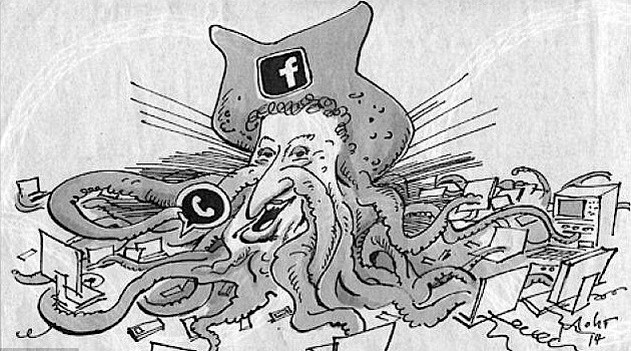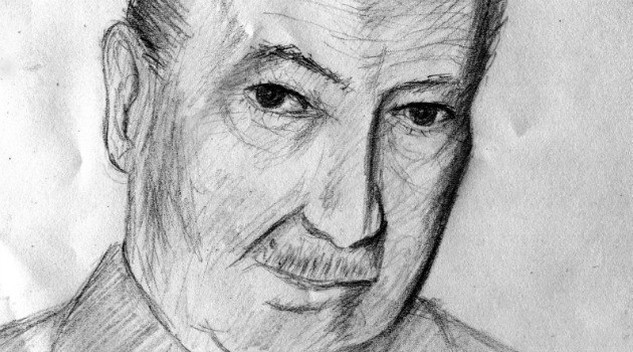 The Forward, February 25, 2014 A caricature of Facebook founder Mark Zuckerberg in a German newspaper has drawn charges of anti-Semitism against the artist and newspaper. As a comment on Facebook’s acquisition of WhatsApp, announced last week, artist Burkhard Mohr depicted the 29-year-old Jewish entrepreneur as an octopus reaching with its tentacles to control social media in the daily German newspaper Süddeutsche Zeitung. With its exaggerated features, including a long nose and thick lips, the cartoon octopus resembles in more ways than one the cartoons published by the rabidly anti-Semitic Julius Streicher in his Nazi-era ”Der Stuermer” magazine. The Simon Wiesenthal Center has protested the depiction, The center’s associate dean, Rabbi Abraham Cooper, told the Algemeiner newspaper that the cartoon was “an outrage” that proves the artist is anti-Semitic. But Mohr denied harboring any such sentiments: He told the Jerusalem Post he was shocked by the interpretation of his drawing, and apologized. Mohr has replaced the caricature of Zuckerberg’s face with a gaping maw.  By Raphael Ahren, Times of Israel, January 21, 2014 Professor Robert Wistrich had bought a ticket to Paris to attend the opening of an exhibition he wrote about the Jewish people’s connection to the Land of Israel, which was supposed to take place Monday at the headquarters of UNESCO. But after the exhibition was indefinitely postponed, without prior warning, due to Arab pressure, he canceled and decided to stay in Jerusalem. Speaking to The Times of Israel, Wistrich – the exhibition’s sole author – said it would be a “euphemism” to say he was unhappy about the sudden death of an exhibition that took him nearly two years of hard work to complete. It showed UNESCO’s “contempt for the Jewish people and its history,” he said. “This is such a betrayal. To do it in this way is so disgraceful,” fumed Wistrich, who directs the Hebrew University’s Vidal Sassoon International Center for the Study of Antisemitism and is one of the world’s leading authorities in the field. An “appalling act,” the cancellation “completely destroyed any claim that UNESCO could possibly have to be representing the universal values of toleration, mutual understanding, respect for the other and narratives that are different, engaging with civil society organizations and the importance of education. Because there’s one standard for Jews, and there’s another standard for non-Jews, especially if they’re Arabs, but not only.” UNESCO’s decision to cancel the exhibit allows just one conclusion, Wistrich added: “That at the end of the day, their mandate, which is to be the United Nations’ organization for the promotion of education, culture and science, is in fact subjected, entirely, to political considerations.” Wistrich also claimed that UNESCO only agreed to host the exhibition to improve its image in the United States, hoping to get the administration to start funding the organization again, after it stopped paying when UNESCO admitted “Palestine” as a member. The historian also took aim at the Obama administration, suggesting the State Department was schizophrenic because it had refused to cosponsor the exhibition — invoking the same reasons that Arab member states used when working successfully to torpedo it — yet later condemned the fact that it was canceled.  By Robert Zaretsky, The Forward, February 14, 2014 On this side of the Atlantic, the imminent publication in Germany of Martin Heidegger’s “Black Notebooks” (“Schwarzen Hefte”) has caused few if any ripples. For better or worse, the philosopher who theorized about “absence from the world” has been largely absent from our world. Yet in Europe, a surf-like pounding in newspapers and magazines has accompanied the debate over the book’s significance. Several phrases leaked from the book have reintroduced some of the great questions about Heidegger: Namely, was he anti-Semitic and, if so, was his existential philosophy fatally compromised? Oddly, the waves of controversy have crashed with greater fury in France than Heidegger’s native Germany, not to mention the Anglo-American world. Of course, this in part reflects the waning, but still important role intellectuals play in French cultural and political life. This interest in turn inevitably spills into the national press, whose front pages have carried numerous interviews and columns on the controversy, leading one literary critic, Eric Aeschimann, to announce the arrival of the “new Heidegger Affair.”  By Kevin Rollason, Winnipeg Free Press, February 7, 2014 Does art stolen by Nazi soldiers from European galleries and private owners grace the walls of the Winnipeg Art Gallery? A federally funded pilot project co-ordinated by the Canadian Art Museum Directors Organization (CAMDO) aims to find out. Stephen Borys, the WAG's director and CEO and also CAMDO president, said the $200,000 provided by the federal government, along with another $200,000 privately raised by the six galleries involved, will allow them to do "provenance research" -- determine the documented history of each painting's ownership through the years. Borys said the two starting points for the project are works created in 1945 and earlier for which the provenance is not known between the years 1933 and 1945. "This is something we have been doing for years -- we do provenance research all the time -- so it's nothing new," he said. "But this program allows us to bring in two internationally renowned researchers to work with our team. We can start looking in a much broader way." The issue is topical -- this weekend, the movie The Monuments Men, starring George Clooney, opens in theatres. It's based on the true story of a platoon ordered by then-U.S. president Franklin D. Roosevelt to recover and return to the owners artworks the Nazis stole and took to Germany before and during the Second World War. "There's a heightened presence," Borys said. "And now, 70 years after the Second World War, the people who would know the pieces are theirs are gone." But he said artworks can be returned to their rightful owners by something as simple as a note in a diary describing a piece. Catherine Chatterley, an adjunct professor of history at the University of Manitoba, said it's believed the Nazis stole hundreds of thousands of art pieces -- as much as 20 per cent of the artworks in Europe. "When the Germans invaded the countries of Europe, they raided museums, art galleries, libraries and research institutes, stealing works of art, books, religious objects, coins, medal collections -- anything of value," she said. "France and Italy were particularly affected by the greatest theft in European history, but so was the Soviet Union, with over 173 museums raided... "The collections were first picked over by (Nazi leaders) Hermann Gring and Adolf Hitler for their own private use, then the remainder was transported back to Germany. The most valuable items, mostly paintings and sculptures, were held in salt mines and caves so as to be protected from aerial bombardment." Chatterley said the haul included works by Matisse, Dégas, Picasso, Botticelli and Raphael and marble sculptures by Donatello and Michelangelo. She said stolen artworks are still being found, citing a case about two years ago where more than 1,400 pieces were discovered in a Munich apartment. "The apartment owner's father had worked for the Nazis, trading in their stolen artwork." Chatterley said it's not unusual for major art galleries to have art with provenance voids during the war years. That includes the National Gallery of Art in Washington, D.C., with more than 400 works, the Art Institute of Chicago, with more than 500, and the Metropolitan Museum of Art in New York City, with 393. Pointing at a large painting entitled Madonna, painted in 1662 by Juan Carreno de Miranda, Borys said: "We're looking at 300 years of provenance. "One of the first things to be destroyed or moved during war is culture." Borys said gallery acquisitions have changed in the last few decades. "If we want to buy an 18th-century painting today, we want to know where it was. We would never buy a piece of art now that has large gaps in its provenance. "The biggest challenge is to get private collectors to co-operate. You can't force a private collector to say, 'I will co-operate.' " |
CISA Blog
This blog provides selective critical analysis on developments in contemporary culture related to the subjects of antisemitism, racism, the Holocaust, genocide, and human rights.
|
© 2025 Canadian Institute for the Study of Antisemitism. All Rights Reserved.
 RSS Feed
RSS Feed